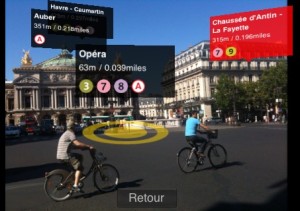 Augmented Reality apps strive to provide a virtual map of the consumer’s surroundings. Layar and several other startups have attempted to make realistic virtual maps in the past, but have often struggled due to the fact that they rely solely on sensor data, which can result in an imperfect match between the virtual depiction and the real environment at hand. However, according to an article recently completed by Tech Crunch, two new patent apps have been released by Apple, which will work to compensate for the imperfection of relying completely on sensor data.
Augmented Reality apps strive to provide a virtual map of the consumer’s surroundings. Layar and several other startups have attempted to make realistic virtual maps in the past, but have often struggled due to the fact that they rely solely on sensor data, which can result in an imperfect match between the virtual depiction and the real environment at hand. However, according to an article recently completed by Tech Crunch, two new patent apps have been released by Apple, which will work to compensate for the imperfection of relying completely on sensor data.
The two patents build on the existing Flyover feature available in iOS maps, which allows users to view a 3-D representation of the satellite image for more interactive directions through a city or street. However, Flyover has never explored the addition of augmented reality previously—something the two patents hope to change, as both patents indicate that Apple has placed a priority on boosting the ability of the navigation programs provided by the iPhone with augmented reality features.
As described by the patent, the iPhone will have a new method of employing and creating the augmented reality, through the use of the camera in combination with on-device software; these two items will work together to generate a virtual map of surroundings for the consumer. The created reality is then overlaid on a real feed, allowing the application to provide a look inside surrounding buildings. The patent claims this is possible through the use of GPS, Wi-Fi and sensor data information, which confirms the user’s position before downloading a 3-D model of surroundings, including local points of interest. The inclusion of the camera in Apple’s patents helps compensate for the imperfect match sometimes found in augmented reality applications. The video feed provided by the camera lets the user’s activity match up virtual elements with the real world equivalents in the image. From there, once a match is locked, users can peel back the outer layers of buildings to reveal the interior.
The software is still in production and is not expected to be on the market in any immediate future. However, the patents do indicate that Apple has made augmented reality a priority in future products.